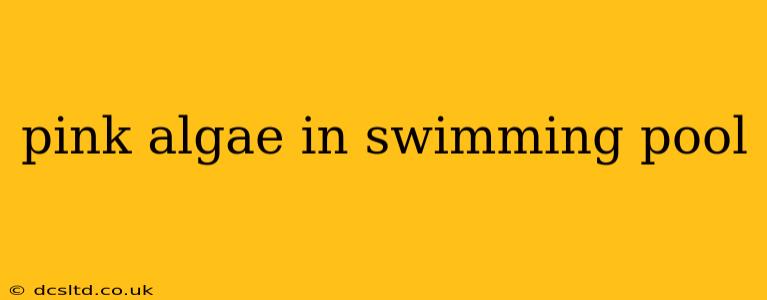Pink algae, scientifically known as Porphyridium cruentum, is a frustrating problem for pool owners. Unlike common green algae, it's more tenacious and difficult to eliminate. This comprehensive guide will equip you with the knowledge to identify, treat, and prevent this unwelcome guest in your pool. We'll explore everything from its unique characteristics to effective eradication strategies.
What Causes Pink Algae in Pools?
Pink algae thrives in environments with high alkalinity, high pH, and inadequate sanitation. It often appears in areas with limited sunlight penetration, such as pool corners, steps, and shaded areas. The algae's vibrant pink or reddish hue comes from its carotenoid pigments. Essentially, it's a resilient organism that finds a foothold in pools where proper maintenance has lapsed. Factors contributing to its growth include:
- Poor water circulation: Stagnant water allows algae to accumulate and flourish.
- Inadequate chlorine levels: Low chlorine levels fail to effectively control algae growth.
- High pH levels: An imbalanced pH level creates a favorable environment for pink algae.
- High alkalinity: Similar to pH, high alkalinity provides an ideal breeding ground.
- Insufficient filtration: A malfunctioning filter system cannot effectively remove algae spores and debris.
How to Identify Pink Algae
Pink algae can be tricky to identify. It often appears as a slimy, pinkish-red film or stain, often clinging to pool surfaces. Unlike other types of algae, it may not cloud the water significantly. It can be mistaken for other staining, so a thorough inspection is crucial. Here's how to differentiate:
- Color: Pink, reddish, or purplish hue.
- Texture: Often slimy or sticky to the touch.
- Location: Frequently found in shadowed or less-circulated areas.
- Persistence: Resistant to standard chlorine treatments.
How to Treat Pink Algae
Treating pink algae requires a more aggressive approach than standard algae removal. A multi-pronged strategy is often necessary.
- Shock Treatment: A high dose of chlorine shock is the first step. Follow the instructions on your chosen shock treatment carefully.
- Algaecide: A specialized algaecide designed for pink algae is essential. These products typically contain stronger chemicals targeting the specific pigments of Porphyridium cruentum.
- Brush and Vacuum: After shocking and treating with algaecide, thoroughly brush all pool surfaces to dislodge the algae. Vacuum the pool floor and walls to remove the loosened algae.
- Backwash/Clean Filter: Clean or backwash your filter regularly to remove the debris and prevent re-contamination.
- Adjust Water Chemistry: Balance your pool's pH and alkalinity levels after treatment to ensure an unfavorable environment for future algae growth. This is crucial for preventing recurrence.
How Long Does It Take to Get Rid of Pink Algae?
Completely eliminating pink algae can take several days, even weeks, depending on the severity of the infestation and the effectiveness of the treatment. Patience and consistent monitoring are key. Regular testing and adjustments to water chemistry are crucial during this period.
How to Prevent Pink Algae
Preventing pink algae is far easier than treating it. Proactive maintenance is your best defense.
- Regular Cleaning: Brush the pool walls and floor regularly to remove debris.
- Consistent Chemical Levels: Maintain proper chlorine, pH, and alkalinity levels. Regular testing is essential.
- Proper Filtration: Ensure your filter system is functioning correctly and clean or replace the filter cartridges as needed.
- Water Circulation: Ensure adequate water circulation to prevent stagnant areas.
- Proper Drainage: Address any drainage issues around the pool that might contribute to contamination.
What are the Health Risks of Pink Algae?
While pink algae is not typically considered highly dangerous, it can still contribute to eye irritation and skin issues. Therefore, promptly address any pink algae outbreak to protect swimmers' health.
Can I use bleach to kill pink algae?
While bleach (sodium hypochlorite) is a form of chlorine, using household bleach directly is not recommended for pool treatment. Pool shock contains a higher concentration of chlorine specifically formulated for pool sanitation and is safer and more effective. Using household bleach might disrupt your pool's delicate chemical balance and could be less effective against pink algae.
Is pink algae dangerous for pets?
Direct contact with pink algae might cause skin irritation for pets, similar to its effect on humans. Treating and preventing pink algae promptly protects both human and animal swimmers.
By understanding the causes, implementing effective treatment strategies, and practicing diligent preventative measures, you can keep your pool free from the persistent pink algae and enjoy clean, healthy swimming for years to come. Remember that consistent monitoring and maintenance are crucial for long-term success.
